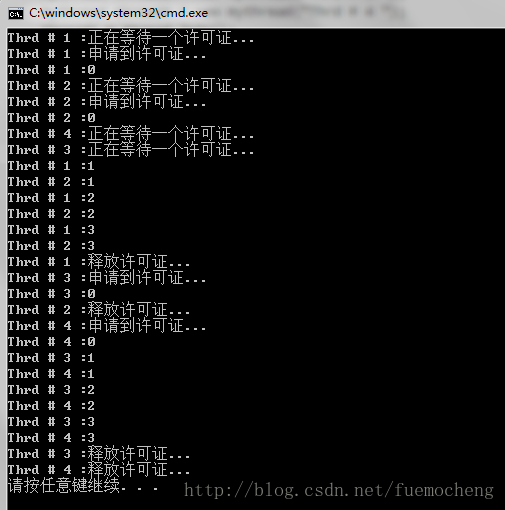参考:
http://blog.csdn.net/feilongzaitianhehe/article/details/51460529
http://www.cnblogs.com/tianzhiliang/archive/2010/08/31/1813635.html
信号量说简单点就是为了线程同步,或者说是为了限制线程能运行的数量。
那它又是怎么限制线程的数量的哩?是因为它内部有个计数器,比如你想限制最多5个线程运行,那么这个计数器的值就会被设置成5,如果一个线程调用了这个Semaphore,那么它的计数器就会相应的减1,直到这个计数器变为0。这时,如果有另一个线程继续调用这个Semaphore,那么这个线程就会被阻塞。
获得Semaphore的线程处理完它的逻辑之后,你就可以调用它的Release()函数将它的计数器重新加1,这样其它被阻塞的线程就可以得到调用了。
类似互斥锁,但它可以允许多个线程同时访问一个共享资源
通过使用一个计数器来控制对共享资源的访问,如果计数器大于0,就允许访问,如果等于0,就拒绝访问。计数器累计的是“许可证”的数目,为了访问某个资源。线程必须从信号量获取一个许可证。
通常在使用信号量时,希望访问共享资源的线程将尝试获取一个许可证,如果信号量的计数器大于0,线程将获取一个许可证并将信号量的计数器减1,否则先线程将阻塞,直到获取一个许可证;当线程不再需要共享资源时,将释放锁拥有的许可证,并将许可证的数量加1,如果有其他的线程正在等待许可证,那么该线程将立刻获取许可证。
另外,允许同时访问的资源的进程数量是在创建信号量时指定的,如果创建一个允许进程访问的信号量数目为1,则该信号量就和互斥锁的用法一样。
// // 摘要: // 初始化 System.Threading.Semaphore 类的新实例,并指定初始入口数和最大并发入口数。 // // 参数: // initialCount: // 可以同时授予的信号量的初始请求数。 // // maximumCount: // 可以同时授予的信号量的最大请求数。 // // 异常: // T:System.ArgumentException: // initialCount 大于 maximumCount。 // // T:System.ArgumentOutOfRangeException: // maximumCount 为小于 1。- 或 -initialCount 小于 0。 [SecuritySafeCritical] public Semaphore(int initialCount, int maximumCount);获取许可证使用WaitOne();
不需要时释放使用 public int Release(),或者public int Release(int releaseCount);
实例:
using System; using System.Collections.Generic; using System.Linq; using System.Text; using System.Threading; using System.Threading.Tasks; namespace ConsoleApp1 { class mythread { public Thread m_thread; static Semaphore m_semaphore = new Semaphore(2, 2); public mythread(string name) { m_thread = new Thread(this.run); m_thread.Name = name; m_thread.Start(); } void run() { Console.WriteLine(m_thread.Name + ":正在等待一个许可证..."); //申请一个许可证 m_semaphore.WaitOne(); Console.WriteLine(m_thread.Name + ":申请到许可证..."); for (int i = 0; i < 4; i++) { Console.WriteLine(m_thread.Name + ":" + i); Thread.Sleep(1000); } Console.WriteLine(m_thread.Name + ":释放许可证..."); m_semaphore.Release(); } } } using System; using System.Collections.Generic; using System.IO; using System.Linq; using System.Text; using System.Threading.Tasks; namespace ConsoleApp1 { class Program { static void Main(string[] args) { MySemaphore(); } static void MySemaphore() { mythread thread1 = new mythread("Thrd # 1 "); mythread thread2 = new mythread("Thrd # 2 "); mythread thread3 = new mythread("Thrd # 3 "); mythread thread4 = new mythread("Thrd # 4 "); thread1.m_thread.Join(); thread2.m_thread.Join(); thread3.m_thread.Join(); thread4.m_thread.Join(); } } } 运行结果:
